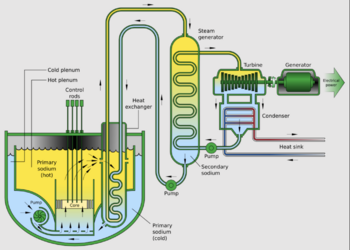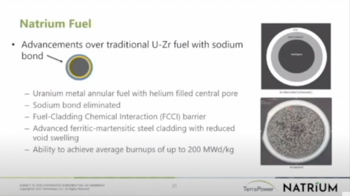Natrium reactor
The Natrium reactor is a Fast Neutron Reactor using uranium metal as the fuel and molten sodium as the coolant.[1] See Integral Fast Reactor for more discussion of the technology behind this design.
This article will address the issues raised in the parent article Nuclear power reconsidered.
Safety
Accidental overheating. The pool of molten sodium has enough heat capacity to absorb the decay heat if there is a total loss of power. Hot sodium will rise by convection and continue the flow of coolant through the core. Proponents of nuclear power call this "walk-away safe".
Leakage of Radioactivity There are no penetrations that could leak in the vessel containing the primary sodium. Secondary sodium is non-radioactive, so a leak in that piping would not be a radiation hazard. The chamber containing sodium circuits can be flooded with argon to suppress any fires.
Sabotage The reactor vessel and all radioactive components are below ground level, under heavy concrete barriers. If a terrorist or rogue operator were to try and force a meltdown, the fuel in the rods would melt before the steel cladding and the reaction would stop.[2] Melted fuel would remain within the rods.[3]
Waste Management
Fast Neutron Reactors can achieve a much higher burnup of the fuel, resulting in fewer grams of spent fuel per megawatt-day compared to Light Water Reactors.[4]
Metal fuel is more easily recycled that standard oxide fuels. This provides much more power from the same fuel.[5]
In a Fast Neutron Reactor most fission products can go back into the reactor with the recycled fuel, reducing the High Level Waste stream.[6]
Long-lived actinides are greatly reduced in a Fast Neutron Reactor.[7]
Weapons Proliferation
Uranium is never more than 20% enriched. Plutonium is burned as fast as it is produced. While it may be possible to extract from the spent fuel a small amount of plutonium, it is contaminated with radioactive nuclides unsuitable for bomb making. A rogue dictator will find it much easier to go the route of every other rogue so far, just buy centrifuges and enrich uranium.
Cost
Specs for a 500MWe plant:
Plant cost per KW (including building but not land, permits or licensing):
Operating cost per KWh (including fuel and maintenance):
Initial fuel load:
Fuel consumption per day:
Further Reading
PLENTIFUL ENERGY The Story of the Integral Fast Reactor, CHARLES E. TILL and YOON IL CHANG, 2011. [1] A thorough presentation of the design and testing of a metal-fueled, sodium-cooled fast reactor.

